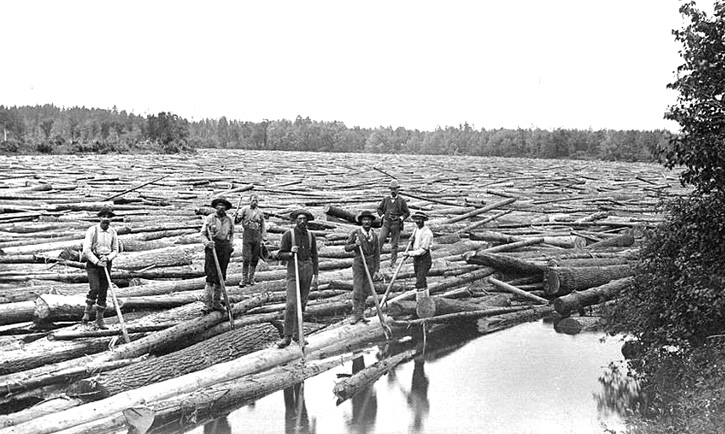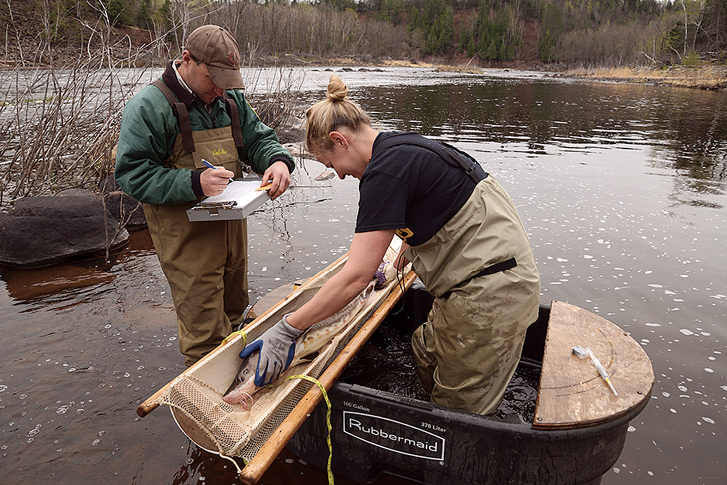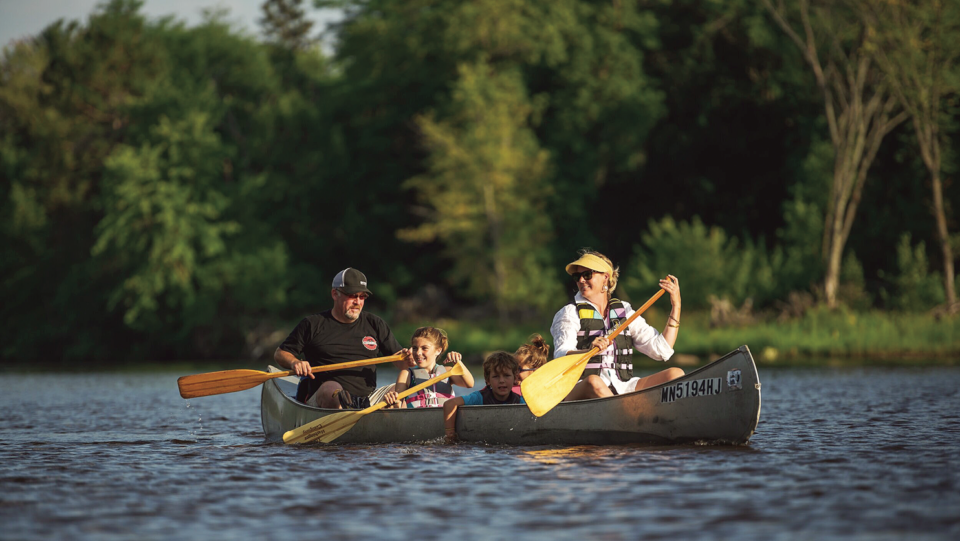Lake Superior, the world’s largest freshwater lake by surface area, has historically served as a transportation artery to connect people and resources within the Great Lakes region.
While numerous settlements and cities have contributed to the expansion of trade and industries on Lake Superior, the port of Duluth-Superior, at the mouth of the St. Louis River, bears the most significance. Since the early 1800s, the 192-mile-long St. Louis River has functioned as the resource centerpiece for economic and industrial growth throughout the Northland and the larger Great Lakes. However, it came with a substantial environmental cost that still lingers today.
Similar to other areas along the North Shore, commercial logging was the first industry to take hold and reshape the landscape and waterways. Logs were harvested near the St. Louis River tributary each spring and floated out to Lake Superior for milling or transportation. Shortly after, steam-powered shipping arrived on Lake Superior following the completion of the Duluth Ship Canal in 1871.
Duluth’s shipping industry focused initially on transporting grain, but by the 1890s, it was shipping millions of tons of iron ore from the Iron Range, according to the Minnesota Historical Society. At the beginning of the 20th century, the U.S. Steel Corporation built a steel plant that included iron ore and coke production facilities. The site encompasses over 700 acres of land and water surrounding Spirit Lake on the St. Louis River.
As industrialization and population growth hounded the Duluth-Superior area, the St. Louis River became the convenient source for the disposal of industrial and untreated waste. Unfortunately, a lack of regulations and sanitation facilities led to haphazard practices of dumping chemicals, toxic pollutants, heavy metals, and sewage into the tributary’s ecosystem.
Despite the growing foul odor, stained brown water, fish kills, and polluted environment, industrial and recreational use continued on the river. However, in the 1950s, a shift occurred that would change the river’s trajectory and, ultimately, Duluth’s economy.

A leader in the 1950s movement to protect the St. Louis River was Willard Munger, a business owner in Duluth whose passion for the magnificent river guided him toward a life-long path of serving in the Minnesota House of Representatives. Munger’s unwavering dedication and grassroots efforts led to Minnesota’s Legislature creating the Western Lake Superior Sanitary District (WLSSD) in 1971. Construction of the facility broke ground in 1974 and went online a few years later, in 1978.
As was the case across the nation in the early 1970s, advocates, environmentalists, sportsmen, and other interest groups banded together to rally for state and federal regulations. The environmental movement of the 1970s created the Clean Water Act in 1972, in addition to numerous other protections.
As momentum continued, the Environmental Protection Agency (EPA) designated the St. Louis River as one of the 31 U.S.-based Areas of Concern (AOC) in the Great Lakes region due to the immense degradation and contamination. According to the EPA, the St. Louis River is the second largest U.S.-based AOC, with over 3,600 square miles of watershed and 1,020 square miles of land.
In order to carry out the habitat restoration and site cleanup work, the EPA required the involvement and formation of a citizen’s group. In 1987, the St. Louis River Citizens Action Committee was established to help guide remedial action plans with agencies and engage the public.
“That was our beginning,” Kris Eilers, the St. Louis River Alliance executive director, said. After that, the committee evolved into what is now recognizably known as the St. Louis River Alliance. “It’s really a grassroots movement to a grassroots citizens group.”
“Ever since then, we’ve been working with the state and state agencies on both sides of the river,” Eilers said. “We’ve continued to work on the Area of Concern.”
While Eilers has been with the non-profit organization for 12 years, her connection to the St. Louis River and the greater Lake Superior derives from visiting the Duluth-Superior area during her childhood. “I saw the pollution happening. And it put something in my heart back then.”
After moving to Duluth in 2010, Eilers found herself at the center of the restoration work on the St. Louis River. “I still kind of pinch myself sometimes that something that was instilled in me when I was a kid is what I’m getting to do now.” To Eilers, the St. Louis River is now a place “of hope and rebirth.”
Following environmental protections on the St. Louis River in the 1970s and 1980s, the Minnesota Department of Natural Resources, the Wisconsin Department of Natural Resources, and researchers at the University of Minnesota Duluth began studying the expansive ecosystem within the 12,000-acre St. Louis River Estuary, at the confluence of the St. Louis River with Lake Superior. The estuary includes numerous bays, wetlands, forested areas, and sandy beaches that provide habitat for fish, amphibians, birds, and countless other species.

One of the leading researchers involved in collecting a comprehensive inventory of bird species within the estuary was Jerry Niemi, a professor emeritus from the Department of Biology at the University of Minnesota Duluth. Niemi said the overall results of the bird inventory were incredible.
After years of research and thousands of hours spent behind binoculars, 302 bird species have been identified within the St. Louis River Estuary system. On an annual basis, 238 bird species use the estuary and Minnesota Point, the 7-mile-long sandbar in the Park Point neighborhood, for bird migration, nesting, and habitat use.
“You can’t find too many places in the state where you’d have that many species observed,” Niemi said. “From a migratory standpoint, the estuary has outstanding numbers of waterfowl, shorebirds, songbirds, etc., migrating to the area.” As a result, the St. Louis River Estuary, in association with adjacent Minnesota Point, is among Minnesota’s best and most popular sites for bird watching. Birders can enjoy viewing marsh wren, alder flycatchers, common terns, green heron, American bittern, and numerous migrating raptors and waterfowl.
While the vast estuary system has a diverse collection of bird species, a certain shorebird, the piping plover, has been the focus for researchers and state agencies. Since the 1970s, populations of the small white and gray shorebird have declined, leading to the species being listed on the endangered species list. “They have not been seen for at least 20 odd years,” Niemi said. Although significant progress has been made in improving habitat within the estuary, Niemi said he thinks the increase in human activity, especially in the sandy cobble beach areas where piping plovers nest, contributes to the species’ decline. “It’s sad to know it’s not here anymore.”
Niemi’s work on the St. Louis River Estuary has been instrumental in identifying the significance of the region. In 2011, Niemi and a colleague Janet Green nominated the St. Louis River Estuary and Minnesota Point as an Important Bird Area (IBA) with the Audubon Society. Although Niemi retired in 2019, he remains active within the St. Louis River birding community. Looking towards the future, Niemi said, “I think there are some wonderful efforts that have taken place over the last number of years in terms of restoration of habitats.” He added, “I’d say right now, it’s been a huge improvement and a very optimistic future for the St. Louis River.”
The optimism and hope that Eilers and Niemi have for the future of the St. Louis River are also shared by Dan Wilfond, the fisheries specialist with the Minnesota DNR. Wilfond works closely with the sturgeon recovery efforts in the St. Louis River. Sturgeon are a native species to the river system but were extirpated in the early 1900s due to habitat alteration, the creation of the hydropower Fond du Lac Dam that impeded historic spawning grounds, water pollution, and over-harvesting of the species. “All of that combined led to the demise of the lake sturgeon in the St. Louis River,” Wilfond said.

After the establishment of the Clean Water Act and the WLSSD in the 1970s, Wilfond said, “we did start to see some recovery of the system.” However, the recovery was slow, so from 1983 to 2000, the DNR stocked 13-year classes of the historic sturgeon species into the river system.
Sturgeons have a unique life cycle and can live to be 100 years old. Due to their long lifespan, the males don’t reach sexual maturity until 12 to 15 years of age, while females take a bit longer and don’t reach maturity until 20 to 25. “It adds a tremendous amount of management challenges,” Wilfond said. “This is a large game of patience.”
The DNR’s patience paid off in the mid-2000s when the DNR encountered the reintroduced tagged fish returning to the spawning grounds in the river. In 2011, officials caught the first naturally reproduced sturgeon fry in the St. Louis River since extirpation in the early 1900s. “That was a really positive sign. Everybody was excited to see that,” Wilfond said.
While plenty of work is yet to be done to restore the sturgeon in the St. Louis River fully, the DNR has made considerable progress in the past 40 years. Other fish species, such as smallmouth bass, muskellunge, and walleye, have been shown to rebound in the St. Louis River. Wilfond said the tributary is now a sought-after destination fishery for anglers. “By no means have we gotten this thing back to its previous condition, but we’re well on our way, and things are looking very good,” Wilfond said.
“It’s incredibly rewarding to see a system that was so heavily impacted, have so many different project collaborators working towards a common goal of restoring a sustainable and healthy estuary,” Wilfond said. “I think everyone should be proud.”
The St. Louis River Estuary has sustained Duluth’s economy, carved out a culture of stewardship and environmentalism, and has remained a point of connection for people and species that are lucky to call it home.
“We believe that it’s really important for us to help try to connect people back to the river so that they can reestablish or build a relationship with the river,” Eilers said. “That’s how people learn to take care of it.”






